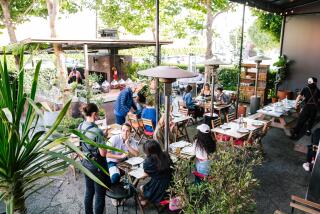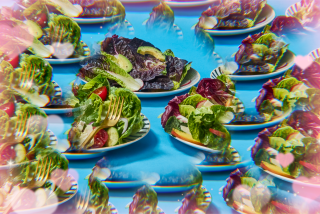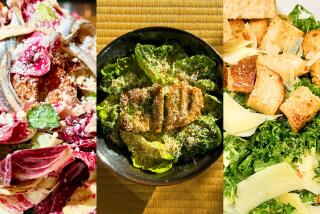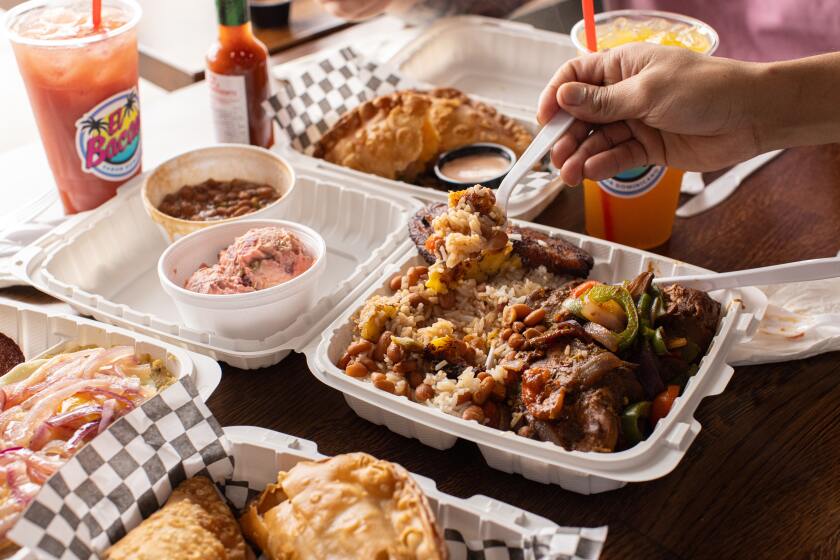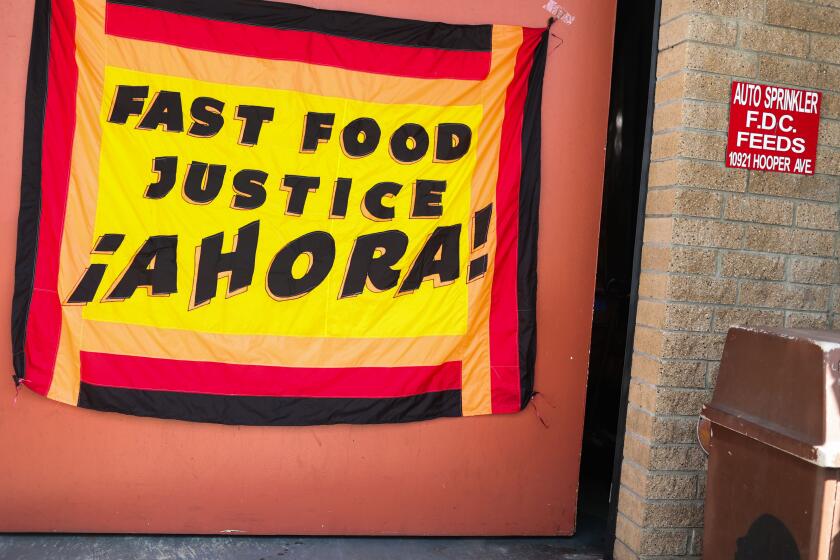The Last Days of Spago
Spago. Can you hold?
Spago. Can you hold?
Spago. Can you hold?
Hello. A table for 8 o’clock? I’m sorry, we’re booked.
Hello. Sorry, we’re full.
Hello. Sorry, we’re full.
Spago. Can you hold?
*
Groucho Marx once said he didn’t want to belong to any club that would accept him as a member. For more than 10 years after Spago opened its doors in 1982, seven phone lines rang incessantly because the restaurant embodied the star-spangled converse of Marx’s axiom: The harder the place was to get into, the more desirable admission became.
Everyone, it seemed, wanted to eat at the hottest, busiest, most celebrated of Hollywood restaurants. It perched above a car rental agency on a scruffy elbow of the Sunset Strip. But it really existed at the intersection where power, wealth and celebrity met a revolution in American cuisine. Spago wasn’t a mythic spot created by the media hype that attended the glamorous parties held there on Academy Awards night. Reality equaled the gushing press coverage. And now one last burst of attention focuses on the Hollywood restaurant this month, before its doors close April 2.
The rickety Spago building had long been aching for a renovation. Three years ago, founder Wolfgang Puck and his wife and partner, Barbara Lazaroff, decided that instead of buying it a face lift, they’d give birth to a lavish new Spago in Beverly Hills’ golden triangle. Puck wanted a bigger showplace where his talents, not the clientele, would star. Business had been declining in West Hollywood, a reflection of changes in the culture of celebrity. And, in a way, the original Spago became a victim of its founder’s creativity. Its casual style and menu have been copied all over the country.
Even when Spago was new, it was never difficult for Sidney Poitier, Michael Caine and Sean Connery to get in. Months after the restaurant opened, a typical night saw them huddled with their wives at a round table in the middle of the room. The champagne flowed, decimated plates of chef Puck’s Jewish pizza--smoked salmon, creme fraiche, chives, red onion and a dollop of caviar layered on a pizza crust--littered the tabletop. Caine, a fabled raconteur, delivered a bull’s-eye of a punch line, and his select audience roared.
The group was having such a good time it was oblivious to the fact that it had brought the place to a standstill. Diners lingered at their tables, as intoxicated by the spectacle of movie stars at play as if they’d inhaled airborne happy dust. The tiny bar area became tightly packed with impatient people, their reservations rendered as valuable as Confederate script. Lazaroff, a formidable presence dressed in her trademark baroque babewear, tried to soothe the wounded egos of those forced to wait. The cooks in the open kitchen on the dining room’s eastern border were stalled; no one was getting up to leave, so no new food orders were placed.
Just in case the situation wasn’t challenging Spago’s staff enough, the private line reserved for VIPs rang, and maitre d’ Henri Labadie took the kind of call that had become routine: Producer Joel Silver, a frequent customer and, like many Spago devotees, a man accustomed to getting what he wanted when he wanted it, was on his way over with a party of eight and expected that his favorite table would be ready.
After midnight on such frenzied nights, Puck would slump at a table over a glass of Cristal champagne, the mother’s milk of Spago, and, in the words of the Eagles, would wonder “how it ever got this crazy.” He had spent hours simultaneously cooking and schmoozing and could still take in the action--a blockade of busboys making it impossible for a tourist to score an autograph from Barbra Streisand; Debra Winger crawling on the floor, searching for a lost earring; Jimmy Connors and Lionel Ritchie sitting on the stairs sharing a pizza while waiting for a table.
Mark Peel was Spago’s first chef at Puck’s elbow. He says, “If there were a way to engineer the kind of heat that Spago had from the beginning, every restaurant would be a success. I knew that it was going to be a hit, even if Wolfgang didn’t. He had a big reputation in town, his concept was innovative, and he knew how to take care of people.”
*
Puck was 25 when he came to Los Angeles in 1975. At 14, he left his native Austria, where his mother was a hotel chef, to serve as an apprentice cook in the south of France and in Paris, then worked briefly in a restaurant downtown before becoming chef at Ma Maison.
Despite being known as the home of the Hollywood power lunch, the little bistro on Melrose Avenue with Astro Turf carpeting and the arrogance to keep its phone number unlisted was on the brink of bankruptcy when Puck took over its kitchen. Cherubic, creative, ambitious yet rather shy, he became a favorite of Ma Maison’s A-list clientele.
It was inevitable that many of them would follow when he moved to his own place in ’82. Initially, Puck wanted to open a neighborhood cafe. He thought that checked tablecloths and sawdust on the floor would be inviting. The decor wasn’t as important as the menu or the ambience he envisioned.
Twenty years ago, when CDs and e-mail didn’t exist, restaurants were dramatically different as well. For those who could afford it, going out to dinner at Los Angeles’ best establishments meant being served multiple courses prepared in keeping with the rigid conventions of French cooking. The food might be exquisite, but gastronomic temples such as L’Orangerie and L’Hermitage were stuffy. “The waiter was wearing a tuxedo, so he was better dressed than you were, and he looked down on customers who couldn’t pronounce what was on the menu,” Puck says.
The classically trained chef didn’t see why intimidation had to be part of the experience. He dreamed of presenting wonderful, surprising food, made of the freshest, best-quality ingredients, in a relaxed atmosphere. His simple concept was radical: Fine dining could be informal. It could be fun.
Like most great, well-timed ideas, the novel cooking style that Puck was experimenting with, later dubbed California cuisine, was also being developed by a number of others: Alice Waters at Chez Panisse Cafe in Berkeley, Michael Roberts at Trumps in West Hollywood and Jonathan Waxman and Ken Frank at Michael McCarty’s Michael’s in Santa Monica. Like them, Puck drew inspiration from California’s mix of cultures, then added a few important, non-culinary elements.
When he took over the lease of Kafka’s, a Russian-Armenian restaurant that had once been a private home, Puck deputized then-girlfriend Lazaroff as interior designer. There wasn’t a lot of money to spend. Twenty-nine limited partners paid $15,000 each for a share of Spago, a name that means “spaghetti” in Neapolitan slang. Don Salk, a dentist who had enrolled in a cooking class taught by Puck, helped recruit investors--other dentists, doctors, stockbrokers and lawyers. That effort didn’t raise enough cash, so Puck and Salk took out a loan, putting their homes up as security.
Lazaroff could spend only $25 each for the 200 chairs and bought wine glasses for $1. She tore down interior walls, creating a space with unobstructed sight lines, the perfect setting for the seeing and being seen that became a Spago sport. She let raw wood beams in the ceiling show, as they would in a Malibu beach shack, and decided to let the cooks be visible too.
“People credit me with inventing the open kitchen, but what about the American diner?” says Lazaroff, who became Puck’s wife in 1984. “The difference is we were creating food of a certain level, right where everyone could see it.”
At Spago, cuisine was theater, and waiters and waitresses were important players in the mise en scene. Puck knew it would be easier to hire a nice person and teach him how to serve than to try to make an experienced but nasty server pleasant. He encouraged the attractive people who donned the uniform of pink striped shirt, pink satin bow tie and bistro apron to be more, rather than less, familiar with customers.
“When everyone knew that all the directors, producers and studio heads were coming to Spago, a lot of aspiring actors and actresses felt they’d have a chance to be discovered if they worked there. A few of the girls did get to sleep with famous actors,” Puck says with a chuckle. “They said, ‘Now we’re in the movie business.’ ”
Well, it was the ‘80s. Occasionally, there were hookers at the bar, people doing cocaine in the bathrooms and having sex in the parking lot. But Spago was never known as the wildest place in town. Once you got in, it was the friendliest. It wasn’t very expensive--although prices doubled in time, when it opened, no entree was priced over $15. Tables were crammed so close together that having a private conversation was impossible. Not only would a perfect stranger at a neighboring table chide Sean Penn for not finishing his dessert, but at the height of his bad-boy period, he’d offer it to her. “As a kid, I dreamed of going to Hollywood, going to Romanoff’s and hanging out with Bogart and Bacall,” says director Henry Jaglom, who ate at Spago almost every night in its first decade. “I had this illusion that there would be a place where you would run into your friends, fellow workers in the film business, and meet new and interesting people. When I came here in the late ‘60s, it didn’t exist. And then it came to pass at Spago. It was a magical, magical place.”
The main room looked like an answer to that hypothetical question: If you could have dinner with any 90 famous people, who would you invite? The hostesses studied the New York Times and the Hollywood trade papers to commit a roster of notables to memory. “We needed to know not only the entertainment people, but who the leading architects were, the artists, writers and Wall Street types,” says Tom Kaplan, Spago’s first general manager.
If Variety hadn’t reported the constant reordering in this company town’s hierarchy, power shifts would be obvious from who sat where. The most coveted tables were at the windows, with their views of the city’s twinkling lights. The back room, which for the first 10 years was a patio protected by only a canvas awning, became known as Siberia. Although Leonard Bernstein, Joni Mitchell, Itzhak Perlman, David Hockney, Ernest Fleischmann, Robert Wagner and George Burns always preferred it, mostly tourists were exiled there.
Some people thought the more they tipped, the better table they would get. Cash could be persuasive, but not as much as many hoped. And just when, where and how quickly someone was seated seemed most pregnant with political meaning, a maverick would defy the system: David Geffen, for example, wasn’t particular. His nonchalance conveyed that wherever he sat was the right spot.
Invitation-Only Oscar Night Party
One night a year, no one complained about the location of their seats. Beginning in 1985, literary agent and Spago regular Irving “Swifty” Lazar controlled the list for an invitation-only Academy Awards party. A cagey autocrat, Lazar would bar anyone who came late, forever banish no-shows and limited even those carrying golden statuettes to one guest. More than anything else, the parties, which ended in 1993, the year Lazar died, earned Spago a priceless international profile.
Except on Oscar night, no Mason-Dixon line separated the glitterati from nobodies, just the members of the Spago club from outsiders. Puck and Lazaroff recognized early that stars could come and go, but the backbone of their business would be “regular people.” So an orthodontist from the Valley who reserved a table twice a week would be treated as well as a Vanity Fair cover boy.
Barry and Judy Wollman of Westwood took 6 or 10:30 reservations, when that’s all they could get. “Then we just kind of wormed our way in,” says Barry, a retired textile executive. “We were plain, ordinary people, but they always made us feel welcome. When we came to celebrate a birthday, we wouldn’t just get a piece of cake with a candle. It would be a whole cake they’d baked just for us, or Wolfgang would make us a magnificent dinner, and refuse to give us a check.”
Puck’s largess was legendary. The Jewish pizza was never on the menu. It was usually delivered to tables gratis, an edible greeting from the chef. Although providing free tastes was a gracious gesture, it also kept customers calm when the kitchen was slow. “We were so busy that often people had to wait for a table, then they had to wait for their food,” says Jannis Swerman, assistant maitre d’ during Spago’s first nine years. “Wolfgang didn’t want people to be hungry and grumpy. So he’d give away so much food that there were people who’d barely have a bill when they left.”
The bonus jackpot was a platter containing every dessert on the menu. Nancy Silverton, the original pastry chef, says Puck “was very smart, very, very generous, and he never wanted anyone to leave unhappy, so he started sending out these assortment platters on the house. People became so attached to them that we couldn’t stop doing it. It was a Spago signature.”
Flexibility was as much a Spago hallmark as generosity. If Dolly Parton liked her foie gras served with a double order of mashed potatoes, she’d get her wish. Baked potatoes were never on the menu, but one would be popped in the oven whenever Barbara Davis’ name was on the reservation list. The late Mark Taper didn’t have to request pureed broccoli. Someone in the kitchen would begin making what they called his baby food as soon as he arrived. Cans of Tab, Haagen-Dazs ice cream and special hot sauce were kept on hand for Omar, a mysterious Middle Easterner who dined at Spago with his entourage seven nights a week for many years.
Puck always remembered that Suzanne Pleshette didn’t like her pasta al dente, and he didn’t balk when she brought in her own spaghetti sauce for the kitchen to reheat. “She likes it sweet, she’s a friend, so I want her to have what she wants,” he says. “I always treated the restaurant like it was my house. The whole pleasure of this business is taking care of people and seeing them going home happy.”
By the early ‘90s, there were many more restaurants able to make customers smile than there had been when Spago opened, and Puck was partially responsible. Neighborhood haunts all over L.A. now have dishes on their menus that Puck invented, and the California Pizza Kitchen chain adapted Spago’s unconventional pizzas for the masses. Today, his influence is everywhere. Salad served with fresh, seared tuna has joined menu vernacular. When Puck first made it, as a variation of salad Nicoise, customers begged for the canned tuna they were used to. Until he served spring rolls as an appetizer, they could be found only in Chinese restaurants. Now, they’re a common feature of the multicultural approach he pioneered.
Spago was always a magnet for talented, ambitious cooks, eager to be mentored by Puck. Several moved on to launch their own places, such as Mark Peel and his wife, Nancy Silverton, who opened Campanile in 1989, the same year she founded La Brea Bakery. Govind Armstrong, executive chef at Chadwick, a buzzy new Beverly Hills spot, began working at Spago when he was 13. Others advanced within Puck’s mini-empire to cook at Granita in Malibu or Chinois in Santa Monica. Today there are Spagos in Chicago, Palo Alto, Las Vegas and Beverly Hills.
The decision to build a new Spago in Beverly Hills was a financial and emotional one. The original restaurant grossed $5.5 million a year in the glory days. By the early ‘90s, when a recession hit, its annual take was $3.5 million. The paparazzi who once spent every evening camped outside began varying their route, making stops at the Ivy, Morton’s and Drai’s. Eclipse, run by former Spago maitre d’ Bernard Erpicum, made a splash for two years, then closed. After the riots in 1992, it seemed people just wanted to stay home.
“When Gregory Peck and Kirk Douglas and those kind of stars would go out, they were making an appearance,” says Michael Dargin, who began as a waiter at Spago when it opened and became general manager five years ago. “The new generation of celebrities, people like George Clooney and Sandra Bullock, don’t want to soak up the limelight the way the previous generation did. The feeling isn’t the same.”
The L.A. restaurant scene continues to evolve. As Patric Kuh, author of “The Last Days of Haute Cuisine” (Viking, 2001), says, “Spago was the first restaurant in a long time that became a brand. Puck showed that quality could be maintained even if a restaurant had several locations. Nobu Matsuhisa is walking the path that Wolfgang forged. Sushi Roku is trying the same thing. There are also a number of small restaurants that people are reacting very positively to. They’re drawn to the human touch.”
Spago, Beverly Hills, is more expensive and grander than its predecessor. “In a way, at the old Spago the celebrity part almost took over,” Puck says. “I really wanted Beverly Hills to be a restaurant where people would take me seriously as a chef. It was time to do something different.”
With both restaurants in operation, some of the old crowd switched their allegiance to the new place. It’s packed at both lunch and dinner, but it doesn’t seem to inspire the affection the original Spago did in its heyday. Puck will always be a draw, and although his many ventures include regular appearances on “Good Morning America,” selling cookware on the Home Shopping Network, hosting a show on the Food Network and overseeing his frozen food line, he still enjoys nothing more than cooking.
When he’s at home in Beverly Hills, where he and Lazaroff live with their 6- and 11-year-old sons, he’s typically busy in the huge kitchen of the new Spago. He wanders into the dining room, where the patter he exchanges with friends and strangers hasn’t changed in years.
“How are you, Wolfgang?”
“Not as good as you.”
“How’s business?”
He glances around the crowded, elegant room, smiles and says, “I think we’ll be open another week.”
More to Read
Eat your way across L.A.
Get our weekly Tasting Notes newsletter for reviews, news and more.
You may occasionally receive promotional content from the Los Angeles Times.
